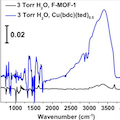Abstract
Water cluster formation and methane adsorption within a hydrophobic porous metal organic framework is studied by in situ vibrational spectroscopy, adsorption isotherms, and first-principle DFT calculations (using vdW-DF). Specifically, the formation and stability of H2O clusters in the hydrophobic cavities of a fluorinated metal–organic framework (FMOF-1) is examined. Although the isotherms of water show no measurable uptake (see Yang et al. J. Am. Chem. Soc. 2011, 133, 18094), the large dipole of the water internal modes makes it possible to detect low water concentrations using IR spectroscopy in pores in the vicinity of the surface of the solid framework. The results indicate that, even in the low pressure regime (100 mTorr to 3 Torr), water molecules preferentially occupy the large cavities, in which hydrogen bonding and wall hydrophobicity foster water cluster formation. We identify the formation of pentameric water clusters at pressures lower than 3 Torr and larger clusters beyond that pressure. The binding energy of the water species to the walls is negligible, as suggested by DFT computational findings and corroborated by IR absorption data. Consequently, intermolecular hydrogen bonding dominates, enhancing water cluster stability as the size of the cluster increases. The formation of water clusters with negligible perturbation from the host may allow a quantitative comparison with experimental environmental studies on larger clusters that are in low concentrations in the atmosphere. The stability of the water clusters was studied as a function of pressure reduction and in the presence of methane gas. Methane adsorption isotherms for activated FMOF-1 attained volumetric adsorption capacities ranging from 67 V(STP)/V at 288 K and 31 bar to 133 V(STP)/V at 173 K and 5 bar, with an isosteric heat of adsorption of ca. 14 kJ/mol in the high temperature range (288–318 K). Overall, the experimental and computational data suggest high preferential uptake for methane gas relative to water vapor within FMOF-1 pores with ease of desorption and high framework stability under operative temperature and moisture conditions.
